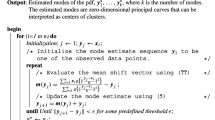Abstract
A new signal processing method is developed for estimating the skew angle in text document images. Detection of the skew angle is an important step in text processing tasks such as optical character recognition (OCR) and computerized filing. Based on a recently introduced multiline-fitting algorithm, the proposed method reformulates the skew detection problem into a special parameter-estimation framework such that a signal structure similar to the one in the field of sensor array processing is obtained. In this framework, straight lines in an image are modeled as wavefronts of propagating planar waves. Certain measurements are defined in this virtual propagation environment such that the large amount of coherency that exists between the locations of the pixels on parallel lines is exploited to enhance a subspace in the space spanned by the measurements. The well-studied techniques of sensor array processing (e.g., the ESPRIT algorithm) are then exploited to produce a closed form and high-resolution estimate for the skew angle.
Similar content being viewed by others
References
Aghajan HK, Kailath T (1992) A subspace fitting approach to super resolution multi-line fitting and straight edge detection. Proceedings of IEEE ICASSP, III, San Francisco, Calif., 121–124
Aghajan HK, Kailath T (1993a)SLIDE: subspace-based line detection. Proceedings of IEEE ICASSP, Minneapolis, Minn., pp 89–92
Aghajan HK, Kailath T (1993b) Sensor array processing techniques for super resolution multi-line fitting and straight edge detection. IEEE Trans Image Processing 2:454–465
Akiyama T, Hagita N (1990) Automated entry system for printed documents. Pat Recogn 23:1141–1154
Baird HS (1987) The skew angle of printed documents. Proceedings of the Conference of the Society of Photographic Scientists and Engineers on Hybrid Imaging Systems, Rochester, N.Y., pp 14–21
Baird HS (1992) Anatomy of a versatile page reader. Proc IEEE 80:1059–1065
Ballard DH (1981) Generalizing the Hough transform to detect arbitrary shapes. Patt Recogn 13:111–122
Casey R, Ferguson D, Mohiuddin K, Walach E (1992) Intelligent forms processing system. Machine Vision Appl 5:143–155
Davies ER (1990) Machine vision: theory, algorithms, practicalities, Academic Press, London
Deans SR (1983) The Radon transform and some of its applications. John Wiley & Sons, New York, NY
Duda RO, Hart PE (1972) Use of the Hough transform to detect lines and curves in pictures. Commun ACM 15:11–15
Fletcher LA, Katsuri R (1988) A robust algorithm for text string separation from mixed text/graphics images. IEEE Trans Patt Anal Machine Intell 10:910–918
Haykin S (1991) Adaptive filter theory (2nd edn) Prentice-Hall, Englewood Cliffs, N.J
Hinds ST, Fisher JL, D'Amato DP (1990) A document skew detection method using run-length encoding and the Hough transform. Proceedings of the International Conference on Pattern Recognition, I, Atlantic City, J.J., pp 464–468
Hough P (1962) Method and means for recognizing complex patterns. U.S. Patent 3069654
Kiryati N, Bruckstein AM (1991) On navigation between friends and foes. IEEE Trans Patt Anal Machine Intell 13:602–606
Nakano Y, Shima H, Fujisawa H, Higashino J, Fujinawa M (1990) An algorithm for the skew normalization of document image. Proceedings of the International Conference on Pattern Recognition, II, Atlantic City, N.J., pp 8–13
Niblack W, Petkovic D (1988) On improving the accuracy of the Hough transform: theory, simulations and experiments. Proceedings IEEE Conference on Computer Vision and Pattern Recognition CVPR '88, pp 574–579
O'Gorman L (1993) The domument spectrum for page layout analysis. IEEE Trans Patt Anal Machine Intell 15:1162–1173
Orfanidis SJ (1988) Optimum signal processing (2nd edn) Mac Millan, New York
Paulraj A, Roy R, Kailath T (1985) Estimation of signal parameters by rotational invariance techniques (ESPRIT). Proceedings of 19th Asilomar Conference on Circuits, Systems and Computers, pp 564–567
Paulraj A, Roy R, Kailath T (1986) A subspace rotation approach to signal parameter estimation. Proceedings of the IEEE, pp 1044–1045
Pavlidis T, Zhou J (1991) Page segmentation by white streams. Proceedings of the First International Conference on Document Analysis and Recognition (ICDAR), St. Malo, France, pp 945–953
Pratt WK, Capitant PJ, Chen W, Hamilton ER, Wallis RH (1980) Combined symbol matching facsimile data compression system. Proc IEEE 68:1120–1132
Roy R, Kailath T (1989) ESPRIT: Estimation of signal parameters via rotational invariance techniqued. IEEE Trans Acoustics, Speech and Signal Processing 37:984–995
Schmidt RO (1979) Multiple emitter location and signal parameter estimation. RADC Spectrum Estimation Workshop, Griffiss AFB, N.Y.
Srihari SN (1992) High-performance reading machines. Proc IEEE 80:1120–1132
Srihari SN, Govindaraju V (1989) Analysis of textual images using the Hough transform. Machine Vision Appl 2:141–153
Taylor SL, Fritzson R, Pastor JA (1992) Extraction of data from preprinted forms. Machine Vision Appl 5:211–222
Viberg M, Ottersten B, Kailath T (1991) Detection and estimation in sensor arrays using weighted subspace fitting. IEEE Trans Signal Processing 39:2436–2449
Xu G, Kailath T (1991) A fast algorithm for signal subspace decomposition and its performance analysis. Proceedings of IEEE ICASSP, Toronto, Canada, pp 3069–3072
Author information
Authors and Affiliations
Rights and permissions
About this article
Cite this article
Aghajan, H.K., Khalaj, B.H. & Kailath, T. Estimation of skew angle in text-image analysis bySLIDE: Subspace-based line detection. Machine Vis. Apps. 7, 267–276 (1994). https://doi.org/10.1007/BF01213417
Issue Date:
DOI: https://doi.org/10.1007/BF01213417




